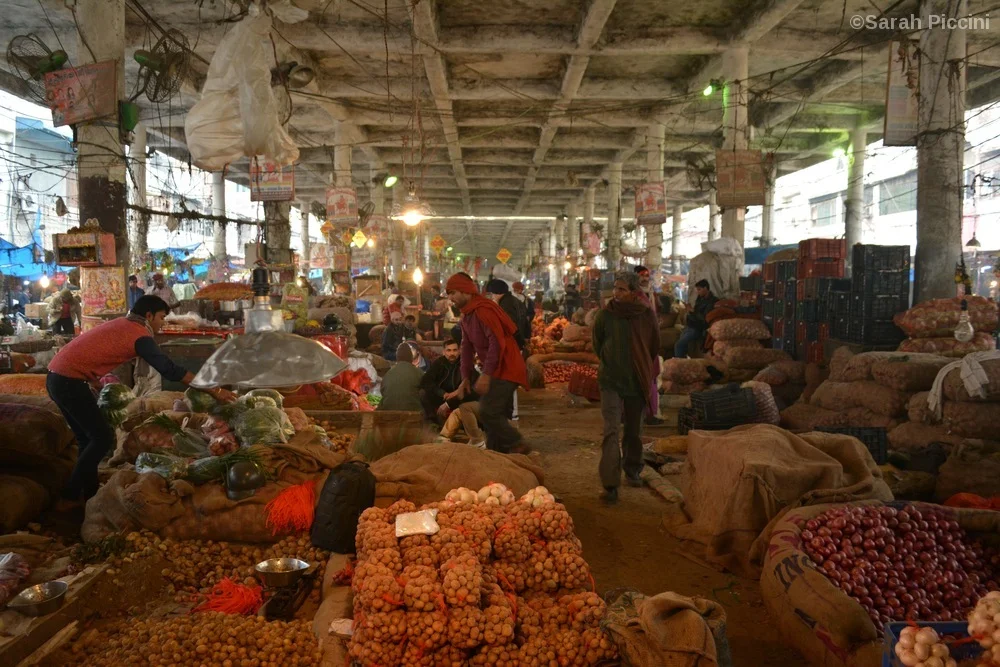BY SARAH PICCINI, CORINNE HOOGAKKER, ARTI SRIVASTAVA, AND BRITTANY GRABEL
Sarah Piccini, Corinne Hoogakker, Arti Srivastava, and Brittany Grabel are second-year International Development students at SAIS. They recently traveled to India to advise the Global Alliance for Improved Nutrition (GAIN) on a strategy for addressing undernutrition in megacities using Delhi, India as a case study.
The IDEV Practicum allows students to work directly with public, private and non-governmental organizations as a capstone to their graduate studies. The IDEV Practicum Blog is a six-part series that chronicles the travels of IDEV students who take on client projects over winter break.
We arrived at Azadpur Mandi while it was still dark. All around us shadows moved, hauled burlap sacks, and bent over to build piles of vegetables on dirty blankets. The mandi (market) is the largest fruit and vegetable wholesale market in Asia. It is a 77-acre maze of shoulder-to-shoulder vending, where produce for Delhi’s 19 million inhabitants makes its way into the city. It is here that the city’s poorest gather to salvage food scraps from the dumpsters, while inside traders – often illiterate themselves – make tremendous fortunes.
Azadpur Mandi itself is a large cement structure whose grey pillars rise high above the stacks of vegetable crates and makeshift vendor tents. Winter kept Azadpur smelling lightly spicy with garlic, ginger, and cut greens, while the heavily trafficked pathways kept us in constant fear of being knocked over by laborers hauling massive sacks.
Our team of SAIS students visited the mandi as part of a research trip with the Global Alliance for Improved Nutrition (GAIN). Our aim was to understand the barriers that low-income Delhi households face in accessing nutritious fresh fruits and vegetables. In Delhi, a staggering 32% of children under five are stunted due to micronutrient deficiencies. We visited Azadpur to interview vendors and trace the supply chain of produce from farm truck to neighborhood market.
Our first interviewee that morning, a vegetable vendor from the state of Bihar, beamed as we slowed down to speak with her. We are researchers, we explained through translations. Her 4 by 3 foot plot displayed small piles of cauliflower, tomatoes, and carrots. How long have you sold vegetables here? we asked. Do you only sell here? Where do you buy your vegetables? Who do you sell them to? Do you feel safe working here? What happens to the vegetables you cannot sell?
She explained to us how she gets up at four o’clock every morning to purchase vegetables from the wholesalers inside the market. Behind the vegetable piles, her two grown-up sons lay resting, wrapped in blankets from crown to toe. They are no use to me, she said, they drink all the time. She described to us how she stays at her stall all day, hoping to sell as much produce as she can. Even so, she makes very little money and rarely leaves the mandi premises for fear of losing her spot. Azadpur is filled with small vendors like herself, who eat, sleep, and work all in one place. From her we learned that while the registered traders do very well at the market, small “informal” vendors such as herself struggle to get by.
As we began to say our thank yous and goodbyes, she stooped with difficulty, and fished out four carrots from her small pile. She pressed one into each of our hands, gave us her blessing, and turned to go back to work.
PHOTO CREDIT: Sarah Piccini.


